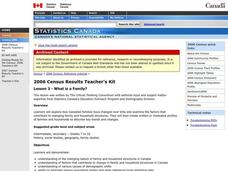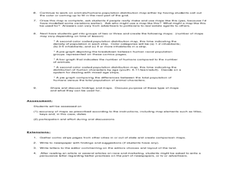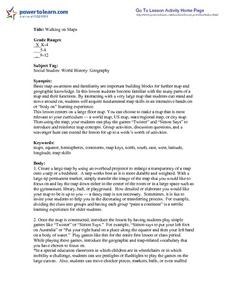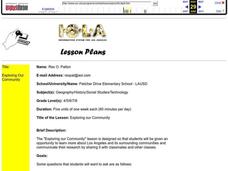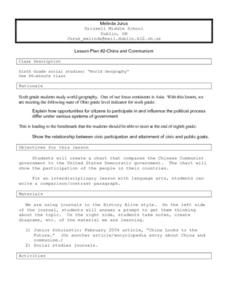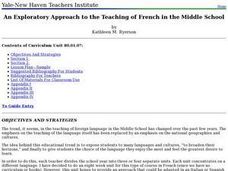Curated OER
A Tale of Two Towns
Young scholars compare their community and region with other communities around the world. In small groups they complete a questionnaire about life in their community and correspond with e-pals, take digital pictures, conduct research...
Curated OER
A Day in the Life
Students inquire about the politics and culture of Ancient Rome. In this Ancient Rome project/unit, students research life during ancient Roman times and create a newspaper with articles on politics, sports, culture, and economics.
Curated OER
What is a Family?
Students explore how Canadian families have evolved over time. In this census results lesson plan, students examine the factors that contribute to changing family and household structures. Students also create written and illustrated...
Curated OER
South Carolina Voices: Lessons from the Holocaust
Students read and summarize two different articles that are based on anit-Semitism. In this Holocaust lesson, students discuss if events in the articles could happen in today's society or not.
Curated OER
Mapping the Border
Students create maps of the borderland region. They decorate their maps with colors, pictures, icons, scenes, words that reflect their understanding of the character and history of the borderland.
Curated OER
You're In My Space!
Students explain how political, social, and economic boundaries can be changed through cooperation and conflict. Small groups are assigned a particular trouble area of the world. Each group studies a particular side of the conflict.
Curated OER
What is the Population Distribution of Cartoon Characters Living On the Pages of Your Newspaper?
Students read various cartoons in their local newspaper and calculate the population demographics, spatial distribution and grouping of the characters. Using this information, they create a population distribution map and share them with...
Curated OER
Rock-a-bye Babies in a Wetland
Pupils review the way human babies grow and what type of care they need. Using the internet, they are introduced to five different wetland habitat animals and how their babies grow. They discover how they are born and what the mothers...
Curated OER
Welcome to New York State
Students choose one region of New York state, and create a travel brochure that includes information such as geographical features, tourist attractions, accesibility, economic features, and historical events that occured in that region.
Curated OER
Biomes of The World
Learners research different biomes, using links from global pen pal letters.
Curated OER
Democracy in Action?
Students compare and contrast democratic election processes. In this 200 presidential election lesson, students visit websites that allow them to compare federal American elections to British elections. Students hold their own classroom...
Curated OER
Because We Can, Should We?
Students identify a position on an issue of geographic importance and support it They read the story "By the Waters of Babylon," and write a paragraph explaining what they think the relationship between Babylon and the Biblical referene...
Curated OER
Walking on Maps
Young scholars are introduced to the various types of maps and their functions. As a class, they play a game similar to twister to review map concepts. They answer questions about the map and use the internet to view larger maps of the...
Curated OER
Making Headlines
Students identify acts of kindness in the news. In this random acts of kindness lesson, students discuss kindness, find a news article about an act of kindness that took place in another country, locate the country on a map, and write a...
Curated OER
A Look at the Population Density of the United States
Young scholars acquire census information and create maps of the population density of the United States on different scales. They role play the roles of workers of a retail company and they use the population data to market to their...
Curated OER
Exploring our Community
Students research Los Angeles and its surrounding communities. They create digital presentations of the information they have gathered by answering the question included in the lesson.
Curated OER
Four Main Directions
Students describe directions using a globe for north, east, south and west. In this mapping activity students identify the north and south pole. Students understand the importance of the equator and the Prime Meridian. Students explain...
Curated OER
French and Indian War
Seventh graders complete a unit on the French and Indian War. They conduct an Internet document search and use what they find to complete a document based essay about the war.
Curated OER
Watersheds, Watersheds Everywhere
Students identify the watershed in which their school is located. They use maps to locate their homes and school. They define and use the correct vocabulary.
Curated OER
China and Communism
Sixth graders discuss what might happen if United States government took over media ownership, read Junior Scholastic article entitled "China Looks to the Future," and create chart comparing Chinese Communist government to United States...
Curated OER
An Exploratory Approach to the Teaching of French in the Middle School
Middle schoolers review the most recent vocabulary list of French words. Using literature by Victor Hugo and Guy de Maupassant, they discover the history and culture of France. Using a map and the text, they locate the cities and...
Curated OER
The Ie Storm 1998: Maps and facts activity
Middle schoolers investigate the St. Lawrence River Valley, ice Storm of 1998. In this middle school mathematics lesson, students interpret ice storm data from tables and maps. Middle schoolers write about their own...
Curated OER
Read a Transportation Story
Sixth graders read a story about intercontinental truck drivers and their journeys. For this transportation lesson, 6th graders read the novel Kamyonistan by Robert Hackford and discuss the travels of the truck driver through the Middle...
Curated OER
Time Signifiers - Past or Present Perfect?
Middle schoolers refine their usage of past simple or present perfect. After a lecture/demo, students work in pairs and utilize a worksheet imbedded in this plan to help them gain practice with time signifiers.




